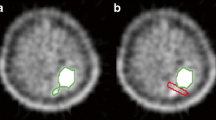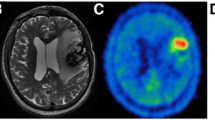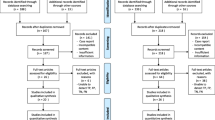Abstract
Objectives
We investigated the potential of textural feature analysis of O-(2-[18F]fluoroethyl)-L-tyrosine (18F-FET) PET to differentiate radiation injury from brain metastasis recurrence.
Methods
Forty-seven patients with contrast-enhancing brain lesions (n = 54) on MRI after radiotherapy of brain metastases underwent dynamic 18F-FET PET. Tumour-to-brain ratios (TBRs) of 18F-FET uptake and 62 textural parameters were determined on summed images 20-40 min post-injection. Tracer uptake kinetics, i.e., time-to-peak (TTP) and patterns of time-activity curves (TAC) were evaluated on dynamic PET data from 0-50 min post-injection. Diagnostic accuracy of investigated parameters and combinations thereof to discriminate between brain metastasis recurrence and radiation injury was compared.
Results
Diagnostic accuracy increased from 81 % for TBRmean alone to 85 % when combined with the textural parameter Coarseness or Short-zone emphasis. The accuracy of TBRmax alone was 83 % and increased to 85 % after combination with the textural parameters Coarseness, Short-zone emphasis, or Correlation. Analysis of TACs resulted in an accuracy of 70 % for kinetic pattern alone and increased to 83 % when combined with TBRmax.
Conclusions
Textural feature analysis in combination with TBRs may have the potential to increase diagnostic accuracy for discrimination between brain metastasis recurrence and radiation injury, without the need for dynamic 18F-FET PET scans.
Key points
• Textural feature analysis provides quantitative information about tumour heterogeneity
• Textural features help improve discrimination between brain metastasis recurrence and radiation injury
• Textural features might be helpful to further understand tumour heterogeneity
• Analysis does not require a more time consuming dynamic PET acquisition

Similar content being viewed by others
Abbreviations
- 11C-AMT:
-
α-[11C]-methyl-L-tryptophan
- 11C-MET:
-
[11C]-methyl-L-methionine
- 18F-FDG:
-
2-[18F]-fluoro-2-deoxy-D-glucose
- 18F-FDOPA:
-
L-3,4-dihydroxy-6-[18F]-fluoro-phenylalanine
- 18F-FET:
-
O-(2-[18F]fluoroethyl)-L-tyrosine
- AUC:
-
Area under the receiver-operating-characteristic curve
- CM:
-
Co-occurrence matrix
- FWHM:
-
Full width at half maximum
- MRS:
-
Magnetic resonance spectroscopy
- NCM:
-
Normalized co-occurrence matrix
- NGLD:
-
Neighbourhood grey level dependence
- NIDM:
-
Neighbourhood intensity difference matrix
- OSEM:
-
Ordered subset expectation maximisation
- ROC:
-
Receiver-operating-characteristic
- SRS:
-
Stereotactic radiosurgery
- SUV:
-
Standardized uptake value
- TAC:
-
Time-activity curve
- TBR:
-
Tumour-to-brain ratio
- TBRmean :
-
Mean tumour-to-brain ratio
- TBRmax :
-
Maximum tumour-to-brain ratio
- TFC:
-
Texture feature coding
- TFCCM:
-
Texture feature coding co-occurrence matrix
- TTP:
-
Time-to-peak
- VOI:
-
Volume-of-interest
- WBRT:
-
Whole-brain radiation therapy
References
Platta CS, Khuntia D, Mehta MP, Suh JH (2010) Current Treatment Strategies for Brain Metastasis and Complications From Therapeutic Techniques. Am J Clin Oncol 33:398–407
Andrews DW, Scott CB, Sperduto PW et al (2004) Whole brain radiation therapy with or without stereotactic radiosurgery boost for patients with one to three brain metastases: Phase III results of the RTOG 9508 randomised trial. Lancet 363:1665–1672
Kondziolka D, Patel A, Lunsford LD et al (1999) Stereotactic radiosurgery plus whole brain radiotherapy versus radiotherapy alone for patients with multiple brain metastases. Int J Radiat Oncol Biol Phys 45:427–434
Kocher M, Soffietti R, Abacioglu U et al (2011) Adjuvant whole-brain radiotherapy versus observation after radiosurgery or surgical resection of one to three cerebral metastases: Results of the EORTC 22952-26001 study. J Clin Oncol 29:134–141
Lippitz B, Lindquist C, Paddick I et al (2014) Stereotactic radiosurgery in the treatment of brain metastases: The current evidence. Cancer Treat Rev 40:48–59
Chen W (2007) Clinical Applications of PET in Brain Tumors. J Nucl Med 48:1468–1481
Greene-Schloesser D, Robbins ME, Peiffer AM et al (2012) Radiation-induced brain injury: A review. Front Oncol 2:1–18
Minniti G, Clarke E, Lanzetta G et al (2011) Stereotactic radiosurgery for brain metastases: analysis of outcome and risk of brain radionecrosis. Radiat Oncol 6:48
Wang Y-XJ, King AD, Zhou H et al (2010) Evolution of radiation-induced brain injury: MR imaging-based study. Radiology 254:210–218
Patel TR, McHugh BJ, Bi WL et al (2011) A comprehensive review of MR imaging changes following radiosurgery to 500 brain metastases. Am J Neuroradiol 32:1885–1892
Kunz M, Thon N, Eigenbrod S et al (2011) Hot spots in dynamic (18)FET-PET delineate malignant tumor parts within suspected WHO grade II gliomas. Neuro Oncol 13:307–316
Boström J, Hadizadeh DR, Block W et al (2013) Magnetic resonance spectroscopic study of radiogenic changes after radiosurgery of cerebral arteriovenous malformations with implications for the differential diagnosis of radionecrosis. Radiat Oncol 8:54
Bélohlávek O, Šimonová G, Kantorová I et al (2003) Brain metastases after stereotactic radiosurgery using the Leksell gamma knife: Can FDG PET help to differentiate radionecrosis from tumour progression? Eur J Nucl Med Mol Imaging 30:96–100
Chao ST, Suh JH, Raja S et al (2001) The sensitivity and specificity of FDG PET in distinguishing recurrent brain tumor from radionecrosis in patients treated with stereotactic radiosurgery. Int J Cancer 96:191–197
Galldiks N, Langen K-J, Pope WB (2015) From the clinician’s point of view - What is the status quo of positron emission tomography in patients with brain tumors? Neuro Oncol 17:1434–1444
Rottenburger C, Hentschel M, Kelly T et al (2011) Comparison of C-11 Methionine and C-11 Choline for PET Imaging of Brain Metastases. Clin Nucl Med 36:639–642
Terakawa Y, Tsuyuguchi N, Iwai Y et al (2008) Diagnostic accuracy of 11C-methionine PET for differentiation of recurrent brain tumors from radiation necrosis after radiotherapy. J Nucl Med 49:694–699
Galldiks N, Stoffels G, Filss CP et al (2012) Role of O-(2-(18)F-fluoroethyl)-L-tyrosine PET for differentiation of local recurrent brain metastasis from radiation necrosis. J Nucl Med 53:1367–1374
Lizarraga KJ, Allen-Auerbach M, Czernin J et al (2014) 18F-FDOPA PET for Differentiating Recurrent or Progressive Brain Metastatic Tumors from Late or Delayed Radiation Injury After Radiation Treatment. J Nucl Med 55:30–36
Alkonyi B, Barger GR, Mittal S et al (2012) Accurate Differentiation of Recurrent Gliomas from Radiation Injury by Kinetic Analysis of -11C-Methyl-L-Tryptophan PET. J Nucl Med 53:1058–1064
Albert NL, Weller M, Suchorska B et al (2016) Response Assessment in Neuro-Oncology working group and European Association for Neuro-Oncology recommendations for the clinical use of PET imaging in gliomas. Neuro Oncol. doi:10.1093/neuonc/now058
Calcagni ML, Galli G, Giordano A et al (2011) Dynamic O-(2-[18F]fluoroethyl)-L-tyrosine (F-18 FET) PET for Glioma Grading. Clin Nucl Med 36:841–847
Pöpperl G, Kreth FW, Mehrkens JH et al (2007) FET PET for the evaluation of untreated gliomas: correlation of FET uptake and uptake kinetics with tumour grading. Eur J Nucl Med Mol Imaging 34:1933–1942
Lohmann P, Herzog H, Rota Kops E et al (2015) Dual-time-point O-(2-[18F]fluoroethyl)-L-tyrosine PET for grading of cerebral gliomas. Eur Radiol 25:3017–3024
Jansen NL, Graute V, Armbruster L et al (2012) MRI-suspected low-grade glioma: is there a need to perform dynamic FET PET? Eur J Nucl Med Mol Imaging 39:1021–1029
Jansen NL, Suchorska B, Wenter V et al (2014) Dynamic 18F-FET PET in Newly Diagnosed Astrocytic Low-Grade Glioma Identifies High-Risk Patients. J Nucl Med 55:198–203
Jansen NL, Suchorska B, Wenter V et al (2015) Prognostic significance of dynamic 18F-FET PET in newly diagnosed astrocytic high-grade glioma. J Nucl Med 56:9–15
Ceccon G, Lohmann P, Stoffels G et al (2016) Dynamic O-(2-18F-fluoroethyl)-L-tyrosine positron emission tomography differentiates brain metastasis recurrence from radiation injury after radiotherapy. Neuro Oncol. doi:10.1093/neuonc/now149
Galldiks N, Dunkl V, Stoffels G et al (2015) Diagnosis of pseudoprogression in patients with glioblastoma using O-(2-[18F]fluoroethyl)-l-tyrosine PET. Eur J Nucl Med Mol Imaging 42:685–695
Galldiks N, Stoffels G, Filss C et al (2015) The use of dynamic O-(2-18F-fluoroethyl)-L-tyrosine PET in the diagnosis of patients with progressive and recurrent glioma. Neuro Oncol 17:1293–1300
Moulin-Romsée G, D’Hondt E, de Groot T et al (2007) Non-invasive grading of brain tumours using dynamic amino acid PET imaging: does it work for 11C-methionine? Eur J Nucl Med Mol Imaging 34:2082–2087
Kratochwil C, Combs SE, Leotta K et al (2014) Intra-individual comparison of 18F-FET and 18F-DOPA in PET imaging of recurrent brain tumors. Neuro Oncol 16:434–440
Marusyk A, Polyak K (2011) Tumor heterogeneity: causes and consequences. Biochim Biophys Acta 1805:1–28
Meacham CE, Morrison SJ (2013) Tumour heterogeneity and cancer cell plasticity. Nature 501:328–337
Tixier F, Le Rest CC, Hatt M et al (2011) Intratumor heterogeneity characterized by textural features on baseline 18F-FDG PET images predicts response to concomitant radiochemotherapy in esophageal cancer. J Nucl Med 52:369–378
Pyka T, Gempt J, Hiob D et al (2016) Textural analysis of pre-therapeutic [18F]-FET-PET and its correlation with tumor grade and patient survival in high-grade gliomas. Eur J Nucl Med Mol Imaging 43:133–141
Castellano G, Bonilha L, Li LM, Cendes F (2004) Texture analysis of medical images. Clin Radiol 59:1061–1069
Chowdhury R, Ganeshan B, Irshad S et al (2014) The use of molecular imaging combined with genomic techniques to understand the heterogeneity in cancer metastasis. Br J Radiol 87:1–15
Murrell DH, Hamilton AM, Mallett CL et al (2015) Understanding Heterogeneity and Permeability of Brain Metastases in Murine Models of HER2-Positive Breast Cancer Through Magnetic Resonance Imaging: Implications for Detection and Therapy. Transl Oncol 8:176–184
Lin NU, Lee EQ, Aoyama H et al (2015) Response assessment criteria for brain metastases: Proposal from the RANO group. Lancet Oncol 16:270–278
Hamacher K, Coenen HH (2002) Efficient routine production of the 18F-labelled amino acid O-2-18F fluoroethyl-L-tyrosine. Appl Radiat Isot 57:853–856
Langen K-J, Bartenstein P, Boecker H et al (2011) German guidelines for brain tumour imaging by PET and SPECT using labelled amino acids. Nuklearmedizin 50:167–173
Herzog H, Tellmann L, Hocke C et al (2004) NEMA NU2-2001 guided performance evaluation of four Siemens ECAT PET scanners. IEEE Trans Nucl Sci 51:2662–2669
Pauleit D, Floeth F, Hamacher K et al (2005) O-(2-[18F]fluoroethyl)-L-tyrosine PET combined with MRI improves the diagnostic assessment of cerebral gliomas. Brain 128:678–687
Fang Y-HD, Lin C-Y, Shih M-J et al (2014) Development and evaluation of an open-source software package “CGITA” for quantifying tumor heterogeneity with molecular images. Biomed Res Int 2014:248505
Haralick RM, Shanmugam K, Dinstein I (1973) Textural Features for Image Classification. IEEE Trans Syst Man Cybern 3:610–621
Loh H-H, Leu J-G, Luo RC (1988) The analysis of natural textures using run length features. IEEE Trans Ind Electron 35:323–328
Amadasun M, King R (1989) Textural features corresponding to textural properties. IEEE Trans Syst Man Cybern 19:1264–1274
Thibault G, Fertil B, Navarro C, et al (2009) Texture Indexes and Gray Level Size Zone Matrix Application to Cell Nuclei Classification. Pattern Recognit Inf Process 140–145.
He D-C, Wang L (1991) Texture features based on texture spectrum. Pattern Recognit 24:391–399
Horng MH, Sun YN, Lin XZ (2002) Texture feature coding method for classification of liver sonography. Comput Med Imaging Graph 26:33–42
Sun C, Wee WG (1983) Neighboring gray level dependence matrix for texture classification. Comput Vision, Graph Image Process 23:341–352
Hanley JA, McNeil BJ (1982) The meaning and use of the area under a receiver operating characteristic (ROC) curve. Radiology 143:29–36
Geertzen J (2012) Inter-Rater Agreement with multiple raters and variables. https:/nlp-ml.io/jg/software/ira/. Accessed 27 Apr 2016
Lowry R (1998) VassarStats: Website for Statistical Computation. http://vassarstats.net/roc_comp.html. Accessed 29 Sep 2016
Cook GJR, Yip C, Siddique M et al (2012) Are Pretreatment 18F-FDG PET Tumor Textural Features in Non-Small Cell Lung Cancer Associated with Response and Survival After Chemoradiotherapy? J Nucl Med 54:19–26
Yang F, Thomas MA, Dehdashti F, Grigsby PW (2013) Temporal analysis of intratumoral metabolic heterogeneity characterized by textural features in cervical cancer. Eur J Nucl Med Mol Imaging 40:716–727
Huang B, Chan T, Kwong DLW et al (2012) Nasopharyngeal carcinoma: Investigation of intratumoral heterogeneity with FDG PET/CT. Am J Roentgenol 199:169–174
Salamon J, Derlin T, Bannas P et al (2013) Evaluation of intratumoural heterogeneity on 18F-FDG PET/CT for characterization of peripheral nerve sheath tumours in neurofibromatosis type 1. Eur J Nucl Med Mol Imaging 40:685–692
Galldiks N, Stoffels G, Ruge MI et al (2013) Role of O-(2-18F-fluoroethyl)-L-tyrosine PET as a diagnostic tool for detection of malignant progression in patients with low-grade glioma. J Nucl Med 54:2046–2054
Bailly C, Bodet-Milin C, Couespel S et al (2016) Revisiting the robustness of PET-based textural features in the context of multi-centric trials. PLoS One 11:1–16
Piroth MD, Liebenstund S, Galldiks N et al (2013) Monitoring of radiochemotherapy in patients with glioblastoma using O-(2-[18F]fluoroethyl)-L-tyrosine positron emission tomography: Is dynamic imaging helpful? Mol Imaging 12:1–8
Acknowledgments
The authors thank Suzanne Schaden, Elisabeth Theelen, Silke Frensch, Kornelia Frey and Lutz Tellmann for assistance in the patient studies; Johannes Ermert, Silke Grafmüller, Erika Wabbals and Sascha Rehbein for radiosynthesis of 18F-FET.
The scientific guarantor of this publication is Prof. Dr. Karl-Josef Langen. The authors of this manuscript declare no relationships with any companies, whose products or services may be related to the subject matter of the article. The authors state that this work has not received any funding.
No complex statistical methods were necessary for this paper. Institutional Review Board approval was obtained. Written informed consent was obtained from all subjects (patients) in this study.
Some study subjects or cohorts have been previously reported in Galldiks N, Stoffels G, Filss CP et al (2012) Role of O-(2-(18)F-fluoroethyl)-L-tyrosine PET for differentiation of local recurrent brain metastasis from radiation necrosis. J Nucl Med 53:1367–1374.
Methodology: retrospective, diagnostic study, performed at one institution.
Author information
Authors and Affiliations
Corresponding author
Rights and permissions
About this article
Cite this article
Lohmann, P., Stoffels, G., Ceccon, G. et al. Radiation injury vs. recurrent brain metastasis: combining textural feature radiomics analysis and standard parameters may increase 18F-FET PET accuracy without dynamic scans. Eur Radiol 27, 2916–2927 (2017). https://doi.org/10.1007/s00330-016-4638-2
Received:
Revised:
Accepted:
Published:
Issue Date:
DOI: https://doi.org/10.1007/s00330-016-4638-2




